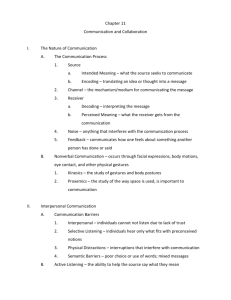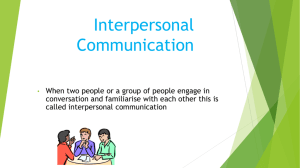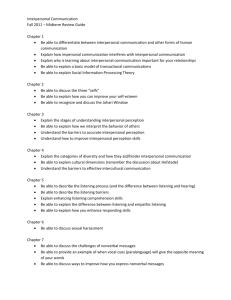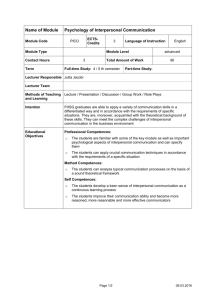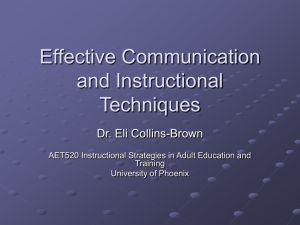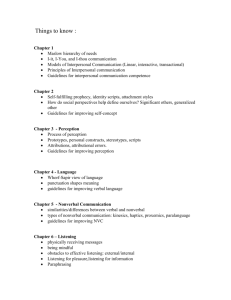docx - JoanMerriam.com
advertisement
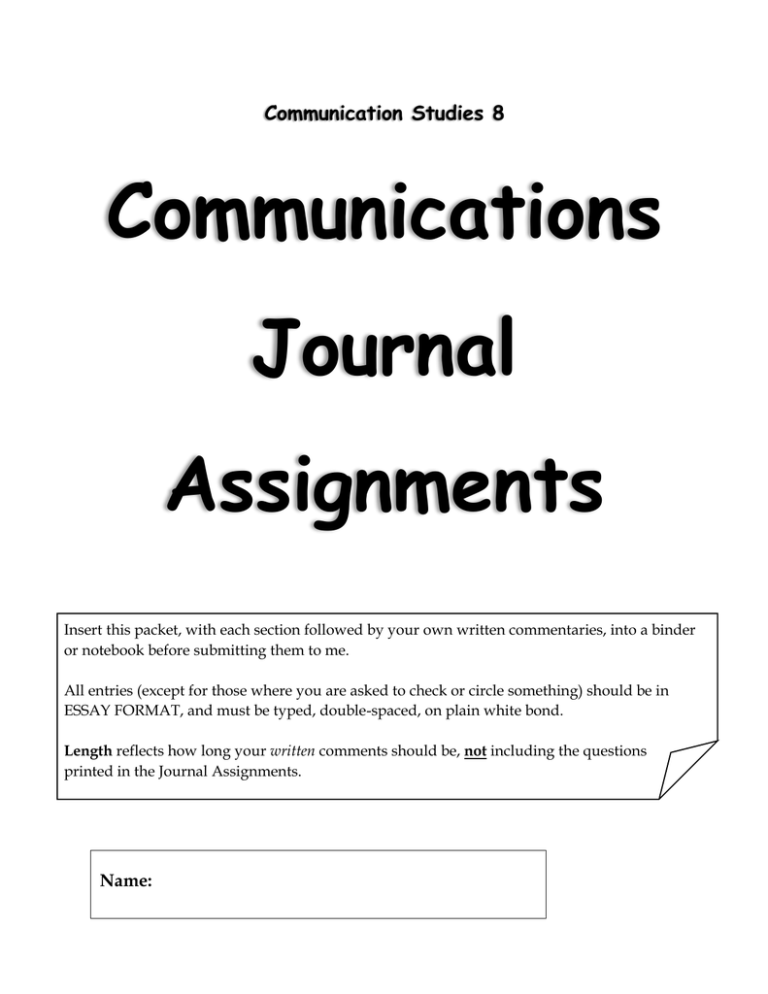
Communication Studies 8 Communications Journal Assignments Insert this packet, with each section followed by your own written commentaries, into a binder or notebook before submitting them to me. All entries (except for those where you are asked to check or circle something) should be in ESSAY FORMAT, and must be typed, double-spaced, on plain white bond. Length reflects how long your written comments should be, not including the questions printed in the Journal Assignments. Name: SECTION 1 ~ Due MARCH 3 ~ 1. RELATIONSHIP ANALYSIS Length: 2-3 pages Using the principles in Chapter 1 of the Adler text, analyze one of your most important relationships: family, friend, or intimate partner. Begin by identifying the person and briefly describe the relationship. 1. What role does self-disclosure play in this relationship? Why do you self-disclose? What benefits have you found in self-disclosure in this relationship? 2. How important is honesty in this relationship? Do you ever use “alternatives” to self-disclosure? What are the results of such behavior? Give a specific example. 3. What is your level of satisfaction in the relationship? What could/should be changed? 4. What is your prediction for the future of this relationship? 2. WHO AM I? Length: 2-3 pages Consider the following 12 statements. I am bossy I am attractive I am serious I am intelligent I am funny I am nosy I am a loner I am backwards I am short-tempered I am high-maintenance I am energetic I am emotional Arrange the statements in terms of how well you believe they describe you, with the first statement being the one that best represents/applies to you, and the last being the one that least applies to you. 1. Why did you rank yourself the way you did? Are you happy with you rankings? 2. Choose two other people in your life whom know you fairly well. For each person, indicate whether you believe they would rank you the same as how you ranked yourself, or whether their rankings would look different. Why or why not? 1 3. Re-create the rankings based upon your “ideal self.” Why did you make the changes that you made? Discuss how you feel about these changes and how they would impact your life. 4. What does this exercise tell you about yourself? Are these perceptions about yourself ones that you would like to change? 3. INTERPERSONAL COMMUNICATION IN YOUR LIFE Length: 3-4 pages Think about a relationship with a family member and a relationship with a friend that has improved over the last few years. Answer the corresponding questions. FAMILY MEMBER: (first name) 1. What changes have taken place in the relationship? 2. What are the interpersonal communication skills that have improved in either you or the other person? 3. How have those changes in the communication skills affected the relationship? 4. What changes in either of your or the other person’s interpersonal communication skills to further improve the relationship? FRIEND: (first name) 1. What changes have taken place in the relationship? 2. What are the interpersonal communication skills that have improved in either you or the other person in the last few years? 3. How have those changes in the communication skills affected the relationship? 4. What changes in either of your or your friend’s interpersonal communication skills to further improve the relationship? General Questions: 1. What interpersonal communication skills have changed in you that are common to both relationships? 2. In what ways have the problems in either relationship been related to ineffective interpersonal communication skills? 2 4. BELIEFS, VALUES, AND ATTITUDES Length: 2-3 pages On a separate piece of paper, complete the following sentences: Values: I value I value I value Beliefs: I believe I believe I believe Attitudes: I like I like I like 1. Which of the things that you identified has the greatest impact on your interactions with other people? 2. Which of the things that you identified has been the newest quality that you’ve added to yourself? 3. Which of the things has been part of who you are the longest? 4. How do these values, beliefs, and attitudes compare to those held by your parents? 5. How do they compare to those held by your closest friend? 3 5. YOUR CULTURAL VALUES Length: 2-3 pages For each of the following dimensions of cultural values, identify those values with which you were raised. Explain how the values you were raised with affected your communication and relationships with others. Masculine vs. Feminine Values you were raised with: Effect on relationships: Individual vs. Group Values you were raised with: Effect on relationships: Tolerance for Uncertainty vs. Need for Certainty Values you were raised with: Effect on relationships: 4 SECTION 2 ~ Due APRIL 5 ~ 0 1. CONVERSATIONAL STYLES and SIGNALS Length: 2-3 pages 1. Recall a conversation you participated in that did not go well. What differences in conversational style could have played a part in “derailing” the conversation? 2. In her chapter on framing, Deborah Tannen discusses the phenomenon of teasing, by which playful insults show affection. What are some of the conversational signals that could indicate to someone you’re talking with that it’s a friendly discussion (“teasing” frame) and not a hostile message (“insult” frame)? 3. Discuss how you personally use direct and indirect communication. Do you tend to be more direct or more indirect? In what ways? In what situations? 4. Discuss how pacing and pausing work among your own family and friends. FAMILY: a. Are there those who you feel are always interrupting? b. Are there those who you feel don’t do their share of talking? c. What factors might affect how pacing and pausing operate in your family? FRIENDS: a. Are there those who you feel are always interrupting? b. Are there those who you feel don’t do their share of talking? c. What factors might affect how pacing and pausing operate in your friendships? 5 2. LISTENING Length: 2-3 pages (not counting the tables) In the following four tables, read each of the descriptions and rank order them from the one that best describes you (as #1) to the one that least describes you (as #4.) Put your rankings in the column marked “ME.” In the same way, rank each description on how well it describes a close friend of the same sex; put these rankings in the column marked “SSF” (Same Sex Friend). In the same way, rank each description on how well it describes a close friend of the opposite sex; put these rankings in the column marked “OSF” (Opposite Sex Friend.) In the same way, rank each description on how well it describes the parent or family member with whom you sometimes have conflicts or misunderstanding; put these rankings in the column marked “FAM.” People Oriented Listener Comfortable with and skilled at listening to people’s feelings, and emotions. Empathetic. Looks for common interests. Other-oriented; seeks strong interpersonal connections when listening. Comfortable interacting inter-personally and in small groups. ME SSF OSF FAM Action Oriented Listener Preference for well organized, brief, and error free information. Dislikes long stories and hearing people digress. Likes people to “get to the point.” Tends to be skeptical about what people have to say. Second-guesses about the other person’s ideas and assumptions rather than accepting things at face value. ME SSF OSF FAM 6 Content Oriented Listener Comfortable listening to complex, detailed information; hones in on the facts, details, and evidence. Rejects messages that lack sufficient supporting evidence and detail. Good judge of accuracy and credibility of information. Does some second-guessing. Comfortable in groups and interpersonal interactions. ME SSF OSF FAM Time Oriented Listener Keenly aware of how much time they have to listen. Wants messages delivered quickly and briefly because they have a lot of things on their to-do list. Not that interested in “Visiting,” wants to get the message and move on. Doesn’t like rambling, or digressions. ME SSF OSF FAM Now, answer the following questions: 1. In what ways do your two strongest listening styles affect how you interact with other people? How does it help? How does it hinder? 2. In what ways do your two strongest listening styles affect what you look for in your relationships with other people? 3. With whom do you have the most similar listening style? How does that similarity affect your interpersonal interactions with that person(s)? How does it affect your relationship? 4. With whom do you have the most different listening style? How does that difference affect your interpersonal interactions with that person(s)? How does it affect your relationship(s)? 3. LOOKING AT NONVERBAL BEHAVIOR Length: 2-3 pages 56 Scene 1: (describe) Emotion being conveyed: (describe) Body movement: Posture: 7 Gestures: Face and eyes: Appearance: Scene 2: (describe) Emotion being conveyed: (describe) Body movement: Posture: Gestures: Face and eyes: Appearance: 1. In both scenes, were you able to quickly and easily “pick up on” the character’s emotion through his or her body language? Why or why not? 2. Now, watch the same two scenes with the sound on. Is there anything in the character’s nonverbal behavior that seems out of context with the words they were saying, or was it a good “match”? In what way? 3. What do you think you could learn from paying closer attention to nonverbal behaviors in film and TV characters as well as people around you? 4. QUESTIONING and RESPONDING Length: 1-2 pages For each of the following statements, create two questions you could ask to get more information from the speaker. Avoid counterfeit questions that trap the other person, carry hidden agendas, seek “correct” answers, or are based on unverified assumptions. EXAMPLE: “It’s not fair that I have to work so much. Other students can get better grades because they have the time to study and go to every class.” How do you feel when other students get higher grades than you? How many hours a week do you work? 1. “I guess it’s OK for you to use my computer, but you need to understand that I’ve put a lot of time and money into it.” 8 2. (Instructor to student) “This paper shows a lot of promise. It could probably earn you an A if you just developed the idea about the problems that arise from distracted driving a bit more.” 3. “We just got started on your car’s transmission. I’m pretty sure you could have it by the end of the day.” 4. “My son never tells me what’s going on in his life…and now he’s moving away.” 5. “I’m really not sure that the movie I saw last night is worth the price of a ticket.” 5. LOOKING AT YOUR PARAPHRASING BEHAVIORS Length: 1-2 pages For each statement, write the number that applies most often in the right-hand column: 1 = Always false 2 = Usually false 3 = Sometimes false/sometimes true 4 = Usually true 5 = Always true I maintain direct eye contact while listening to others. When I listen, my body posture is open and relaxed My arms and legs remain uncrossed when I am listening. I use gestures and nod my head appropriately in response to other’s comments. I effectively use my face to express reactions to what I hear. My voice tone and volume are adapted to the way the other person talks. I am effective at asking appropriate follow-up questions. I am particularly effective at accurately paraphrasing the content of what I hear. I am particularly effective at accurately paraphrasing the emotions being expressed or felt by the other person My paraphrasing is appropriately timed and does not interrupt the other. Total your answers. A score of 40 to 50 indicates effective listening and paraphrasing. A score around 30 indicates some effectiveness, but a need for improvement. A score of less than 25 probably indicates a need for a more concentrated effort to improve. Question: Examine the individual items for those you have scored 3 or less on. What could you do to improve each of those behaviors? 9 5(a). PARAPHRASING PRACTICE Length: 2 pages The most helpful paraphrasing responses reflect the speaker’s thoughts and feelings. In order for this style of helping to be effective, you also have to sound like yourself, and not a robot or parrot. There are many ways to paraphrase effectively: “It sounds like you’re…” “I hear you saying that…” “Let me see if I understand. You’re saying…” “So you’re telling me…” “And so…” “Is it that you…” “Are you…” “Do you mean…” Leave your paraphrases open (tentative) by using words that invite the speaker to clarify or correct your paraphrase (for instance, ”Is that right?”). EXAMPLE: “Stan always wants to tell me about the woman he’s currently going out with or the project he’s currently working on. He gives me details that seem to take hours, but he hardly ever asks me what’s going on in my life.” “It seems like you might be tired of hearing about Stan’s love life, and that you’re feeling a little irritated that he doesn’t seem at all interested about what’s important to you.” Copy each statement below, then write a paraphrase response for each one. Be sure the response fits your style of speaking, while at the same time reflecting the speaker’s thoughts and feelings. 1. “I hate this instructor. First he told me my paper was too short, so I gave him more information. Now he tells me it’s too wordy.” 2. “We can’t decide whether to put my grandfather in a nursing home. He hates the idea, but he can’t take care of himself any more, and it’s just too much for us.” 3. “She believed everything he said about me. She wouldn’t even listen to my side— just started yelling at me. I thought we were better friends than that.” 4. “I’m really starting to hate my job. Every day I do the same, boring thing. But I’m afraid that if I quit, I’ll never be able to find another job.” 5. “How can I tell him how I really feel? He’ll just get mad, or he’ll think I don’t love him, then we’d start arguing. I just don’t know what to do.” 6. “Why don’t you try to be a little less messy around here? Our friends must think this place looks like a dump.” 10 SECTION 3 ~ Due MAY 3 ~ 10 1. APPLYING KNAPP’S MODEL OF COMMUNICATIOM Length: 3-4 pages Think of a romantic or close relationship that has ended, and describe how that relationship reflected each element of Knapp’s Model of Communication below: Initiating: Differentiating: Experimenting: Circumscribing: Intensifying: Stagnating: Integrating: Avoiding: Bonding: Terminating: 2. SHIFTING PERSPECTIVES (PILLOW METHOD) Length: 3-4 pages Select a disagreement or conflict that is now affecting (or that recently affected) an interpersonal relationship. This could be a personal issue (“I want to move to another state; my partner/spouse wants to stay in California”) or a more public one (“I think that supporting a third-party candidate helps our democracy; my friend thinks it undermines democracy by drawing votes away from the two parties.”) Record enough background information for me to understand your stance on the issue. (For instance, who is involved? How long has the conflict been going on? What are the basic issues?) Describe the issue from each of the four positions below, and then discuss your conclusions. Position 1: “I’m right and you’re wrong.” Explain how you’re right and the other person is wrong. Position 2: “You’re right and I’m wrong.” Explain how the other person’s position is correct, or at least understandable. 11 Position 3: “We’re both right and we’re both wrong.” Show how there are correct (or understandable) as well as mistaken (or unreasonable) parts of both positions. Position 4: “The issue may be less important than it seems; some other things may be more important.” Describe two ways in which the elements developed in positions 1-3 might affect your relationship. Describe one way in which the issue might be seen as less important than it was originally, and one way in might be seen as more important than it was originally. Your Conclusions: 1. Explain how there’s some truth in each of the 4 positions. 2. Explain how viewing the issue from each of the positions might change your perception of the issue, and how it might change your behavior in the future. 3. Explain how this issue and your understanding of it affect your relationship. 3. YOUR COMFORT WITH TOUCH Length: 2-3 pages For each of the following statements, number them in the right-hand column according to the following scale in terms of how comfortable or uncomfortable you’d be with each scenario: 1 = Comfortable 2 = Neutral 3 = Uncomfortable Someone’s arm touching yours while standing in a crowded elevator A casual friend of the opposite sex putting a hand on your shoulder while asking a favor. A close friend of the same sex putting his or her arm on your shoulder while sharing very personal information. A student of the opposite sex that you sit by grabbing your arm and holding it as they excitedly tell you of their great grade on a paper that was just returned. A person you’ve just begun dating reaching out to touch you while you are sitting together watching a TV program Your spouse or intimate partner reaching out to touch you while you are sitting together watching a TV program. Receiving a hug from a family member you don’t know very well. Receiving a hug from your mother when you return home from a trip. 12 Receiving a hug from your father when you return home from a trip. Being patted on the back/shoulder as you say goodbye to a same sex friend. Being patted on the butt by a teammate after you made a good play. The side of your thigh touching a stranger’s thigh while sitting next to you on a crowded plane or bus. Now, answer these questions: 1. Overall, do your scores indicate whether you are generally comfortable or uncomfortable with touch? How satisfied are you with your level of comfort? Why or why not? 2. What patterns do you notice among those items on which you scored high or low? 3. What factors or experiences in your life have contributed to your responses to touch listed above? 4. A CLOSER LOOK AT YOUR CONFLICT STYLE Length: 3-4 pages First, review your Conflict Styles Assessment results. In your paper, indicate your scores in each of the five categories (competition, collaboration, compromise, avoidance, accommodation). 1. Do you feel that the scores reflect your style(s) in managing conflict? 2. Does your conflict style ever change? If so, what prompts the changes (e.g. certain people, situations, times, issues, etc.)? Provide specific examples. 3. What factors do you think “taught” you how to deal with conflict? Which were the most influential? Do you believe these were positive influences or negative influences? 4. Do most of your conflicts end in a satisfactory or unsatisfactory manner? Why do those outcomes occur? 5. Are there any aspects of the way you deal with conflict that you would like to change? 6. Why? What practical steps can you take to change these behaviors? 13

